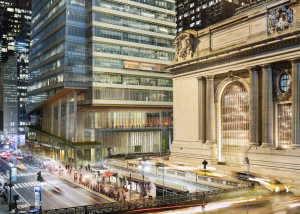
Architect’s rendering of One Vanderbilt Place and Grand Central Terminal. Image credit: Kohn Pedersen Fox Associates
Representatives from the project developers, Grand Central Terminal, and private citizens argued the proposal. On February 4, 2015 the City Planning Commission held a public hearing on the proposed One Vanderbilt skyscraper project. The proposed building would be 1,450 feet high and take up a block bounded by Madison Avenue to the west, Vanderbilt Avenue to the east, 42nd Street to the south, and 43rd Street to the north. The project would also include transit improvements to the overcrowded Lexington Avenue subway station in Grand Central, as well as accommodate the projected influx of riders once the MTA East Side Access program is completed. On December 11, 2014 Manhattan Community Boards 5 and 6, through the Multi-Board Task Force on East Midtown Rezoning, recommended denial of the project. On January 29, 2015 Manhattan Borough President Gale Brewer gave a conditional approval of One Vanderbilt after negotiating additional community benefits with project developer SL Green.
Mark Holliday, CEO of SL Green, testified the project was necessary to maintain East Midtown as a premier business district. Mr. Holliday argued businesses preferred transit-oriented neighborhoods such as East Midtown, but were moving to areas with less transit that offered newer commercial construction and modern office space, and One Vanderbilt is needed to keep businesses in place. Rob Schiffer, managing director at SL Green, testified about the transit improvements of the project. Mr. Schiffer pinned the delays at Grand Central on inefficient crowd movement, increasing the time needed to load and offload passengers, and delaying train departures. A program of reducing obstacles on the subway platforms and mezzanine, adding and widening stairways, and improving street access would result in a net increase of one extra train per hour at peak travel times. Mr. Schiffer also described plans to create a path through One Vanderbilt’s footprint that would funnel projected East Side Access LIRR riders to transit connections and desired exits without forcing them through the dining concourse of Grand Central and the existing Metro-North riders. Council Member Dan Garodnick gave an endorsement of the increased opportunity for public comment in the process, saying “Many of my concerns from last term do not exist because the City maintains full discretion to approve or deny each application.”
Local resident Alexander Shapiro testified in opposition to the project and argued in favor of protecting the original Terminal City concept that was anchored on Grand Central Terminal. Representatives for Andrew Penson, owner of Grand Central, testified in opposition to the plan. Laurence Tribe, a professor of Constitutional law at Harvard Law School on retainer to Boies, Schiller & Flexner, argued the rezoning and construction of One Vanderbilt would amount to an unconstitutional taking of Mr. Penson’s property in the Grand Central transferable development rights. Mr. Tribe stated by negotiating directly with SL Green to grant development rights in exchange for transit improvements instead of buying the Grand Central rights from Mr. Penson, the city invalidated the original granting of development rights when Grand Central was landmarked in the 1960s, diminishing the value of the rights without proper compensation. Chairman Carl Weisbrod rejected the argument, saying SL Green had the option to make transit improvements or buy the rights from Grand Central, and chose to make the improvements. “How can you say your client’s [rights] are worthless when SL Green could have bought them for $200 million?”, the value of the transit improvements. Commissioner Anna Levin pushed further, saying there is a transfer of landmark rights in the project from the Bowery Savings Bank, owned by SL Green. The commissioner also argued the zoning text change would make it easier for Mr. Penson to transfer his rights by allowing a larger bundle of rights to transfer and without the requirement of major transit improvements in connection to the transfer. Paul Selver of Kramer Levin argued that the deal unlawfully allowed the city to reap a financial benefit from granting a zoning bonus by relieving itself of the financial burden of improving the Lexington Avenue subway. Duane Loft of Boies, Schiller & Flexner stated no developer would take a different deal than SL Green’s, arguing no one would buy Grand Central’s rights if they can “cut a backroom deal” with the city for transit improvements.
CPC: Vanderbilt Corridor (140440-MMM, 150127-ZRM), One Vanderbilt Avenue (150128-ZSM, 150129-ZSM, 150130-ZSM, 150130(A)-ZSM) (Feb. 4, 2015).
By: Michael Twomey (Michael is the CityLaw Fellow and a New York Law School graduate, Class of 2014).


Very cool project and I guess you would say it is about time. No improvements have been made under the 1960 development rights of Grand Central and it seems that SL Green says it is time. This will greatly enhance access to the station and spiff up an area in need of some life and modernization. Good work!